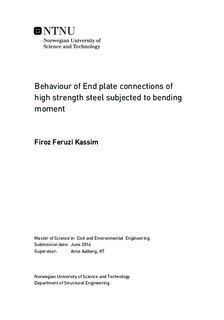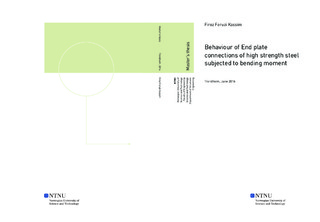| dc.contributor.advisor | Aalberg, Arne | |
| dc.contributor.author | Kassim, Firoz Feruzi | |
| dc.date.accessioned | 2019-09-11T08:34:56Z | |
| dc.date.available | 2019-09-11T08:34:56Z | |
| dc.date.created | 2016-06-14 | |
| dc.date.issued | 2016 | |
| dc.identifier | ntnudaim:15799 | |
| dc.identifier.uri | http://hdl.handle.net/11250/2614906 | |
| dc.description.abstract | NS-EN 1993-1-8 is part of the Eurocode 3 series, which deals mainly with the design of joints in steel structures. It provides rules and procedures for calculating the capacity and the rotational stiffness of joints in a steel-framed structure. The sets of rules and guidelines provided in NS EN 1993-1-8 are mainly applied for structural joints connections with either H or I section and covering various steel grades from S 235 to S 460. Different types of connections such as in this case rectangular hollow sections with extended end plate connections are not covered in the Eurocode including structures with high strength steel. Therefore, this investigation focuses on examining the structural behaviour of end plate connections of high strength steel subjected to bending moment when applying the rules from the NS EN 1993-1-8.
Series of laboratory tests were conducted on two different joint specimens and both of them consisted of end plates that were made of high strength steel, i.e. Weldox 700. Numerical analyses of these tests were conducted in Abaqus CAE so as to observe the deformation patterns of the connection. The results obtained from the numerical simulations were compared to the experimental results and hand calculations from the Eurocode.
The comparisons shows that the hand calculations generally overestimates the initial stiffness obtained from the experiment depending on the specimen and it s bending axes. The numerical simulations substantially underestimates the initial stiffness from the experimental results, yet gives good prediction concerning other results. Both analysis models, i.e. the numerical simulation and hand calculation show that it s difficult to predict the initial stiffness.
The capacity calculations from both analysis models produces acceptable results that are within the range of the capacity obtained from the experiment.
A parameter study was conducted in the finite element program Abaqus CAE in order to determine the optimal number of elements within the thickness of the end plate. This was executed by assigning different volume elements (C3D8R and C3D20R) to the end plate, which was modelled as simply supported beam so as to determine the deflection in the middle. The deflection obtained in Abaqus was then compared to the analytical deflection.
Finally the Abaqus models, which were used in the numerical analysis in this investigation were evaluated to determine if the analysis produced were accurate. This was done by increasing the number of elements on the RHS profile and then comparing its results to the original Abaqus models that were used in this investigation. | en |
| dc.language | eng | |
| dc.publisher | NTNU | |
| dc.subject | Bygg- og miljøteknikk (2-årig), Prosjektering av konstruksjoner | en |
| dc.title | Behaviour of End plate connections of high strength steel subjected to bending moment | en |
| dc.type | Master thesis | en |
| dc.source.pagenumber | 150 | |
| dc.contributor.department | Norges teknisk-naturvitenskapelige universitet, Fakultet for ingeniørvitenskap,Institutt for konstruksjonsteknikk | nb_NO |

